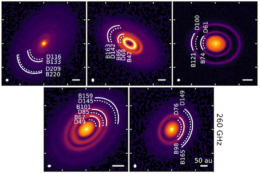
This ALMA image of the protoplanetary disk surrounding the star HL Tauri reveals the detailed substructure of the disk, including gaps that may have been cleared by planets. [ALMA (ESO/NAOJ/NRAO)]
Now, a team of astronomers has carried out a new observing program to understand the physical and chemical conditions in planet-forming disks around young, nearby stars: Molecules with ALMA at Planet-forming Scales (MAPS). The MAPS program consists of high-resolution observations of protoplanetary disks around five stars — IM Lupi, GM Aurigae, AS 209, HD 163296, and MWC 480 — in which planet formation is thought to be happening right now.
This sample of protoplanetary disks and their host stars spans different spectral types and contains a variety of intriguing structures seen in both gas and dust emission. With ALMA, we can see small-scale (7-30 au) details stretching from less than 10 au from the star to the outer reaches of the disk at 1,000 au. In total, the team measured roughly 40 spectral lines arising from the presence of 20 chemical species, giving an unprecedented view of the chemistry of these disks. A new special issue of the Astrophysical Journal Supplement Series presents the first results in a collection of 20 articles.
Some of the key findings described in these articles include:
- Radial and vertical distribution of line emissions
The MAPS program revealed that emissions from different chemical species — and even different emission lines of a single chemical species — can arise from a variety of locations within a disk. These chemical structures also vary widely between the five disks in the MAPS sample. Because the MAPS observations probe the vertical direction (above and below the midplane of the disk) as well as the radial direction, the team was able to determine whether the organic molecules detected are present in the midplane of the disk, where planets form.
- Molecular abundances
ALMA observations of molecular line emissions allow for calculations of elemental and molecular abundances, which increase our understanding of the gaseous material from which planets form. An especially enticing result of the MAPS program is the discovery that these protoplanetary disks contain reservoirs of nitriles, a class of organic compound that may have played a key role in the development of life on Earth. Nitriles and other small organic molecules were found to be distributed unevenly throughout the disks, suggesting that the location at which a planet forms has profound implications for its chemical makeup and potential for development of life.
- Disk structure and properties of the gas
Previous studies with ALMA have revealed the presence of structures like rings, gaps, and spirals in protoplanetary disks. MAPS detected roughly 200 of these features, with some amount of structure visible in every molecule surveyed. The structures visible in the molecular-line emission often coincide with structures seen in the dust continuum emission, but not always, suggesting that a variety of physical processes are responsible for the presence of disk substructure seen in both gas and dust.
The MAPS observations provide among the most detailed views to date of the planet-forming environment around young stars. Further analysis of these observations promises to illuminate the interplay between gas and dust and advance our understanding of how the chemistry of protoplanetary disks influences planet formation.
Citation
Special ApJS Issue on the MAPS program
“Molecules with ALMA at Planet-forming Scales (MAPS) I: Program Overview and Highlights,” Karin Öberg et al 2021 ApJS 257 1. doi:10.3847/1538-4365/ac1432


